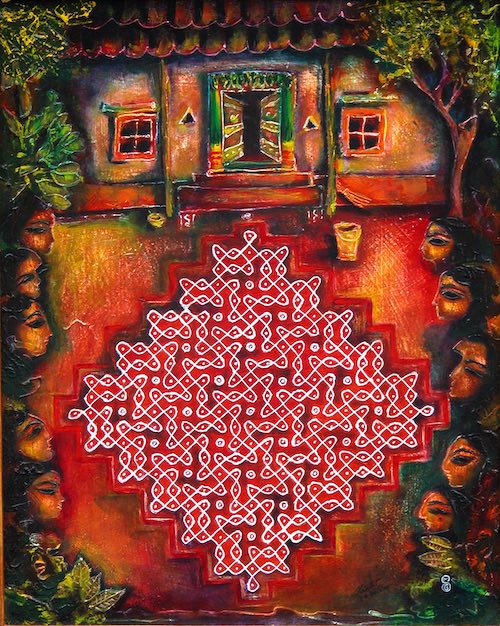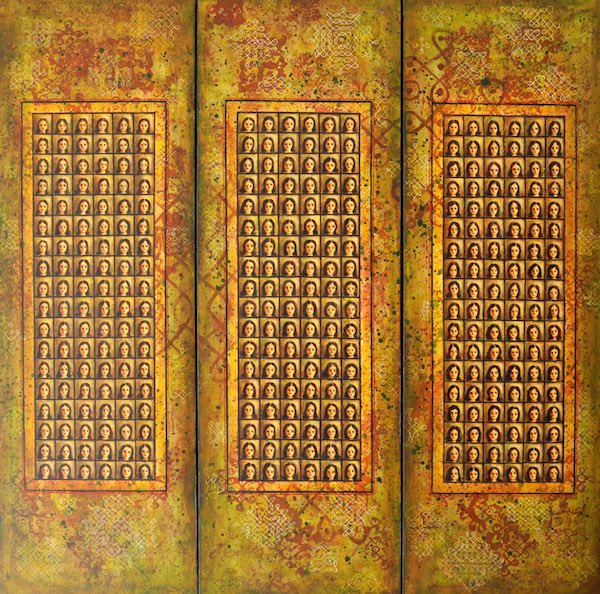Kolams: The Geometrical and Mathematical Beauty of Traditional Indian Art
- Kolams serve as a reminder of impermanence and non-attachment, teaching to let go as complex beautiful patterns are drawn with the knowledge that they will fade away soon.

Ancient traditional art forms from around the world fascinate me, but it was not always like that. I grew up in a small cosmopolitan township in Tamil Nadu, learning about many other cultures alongside local Tamil traditions, taking the cultural diversity that we experienced for granted. It was only after I got married and moved with my family to other countries did the significance of traditional arts dawn on me. I started incorporating motifs from traditional Indian art in my own artwork, and it was Kolams that I connected with the most.
Every morning at sunrise, and sometimes at sunset, Tamil women clear the ground in front of their house and draw a Kolam, a pattern of dots and lines using rice or rock powder, as a symbol of welcome and to bring good energy into the household. It is an ancient tradition that continues to be performed as a daily ritual and has been handed down from generation to generation. I learned to draw Kolams from my mother and grandmother by watching them and listening to their interpretations and philosophies.

Pulli Kolams
Kolams are drawn on the floor or directly on earth without the use of any measuring tools. In Pulli Kolams, the dots are laid down first in evenly spaced grids. Lines either weave around these dots to create one or more closed loops or connect them. Kolams could be simple or complex patterns, and sometimes include images like flowers, leaves, or conches. On special occasions, Kolams are filled with colored powder or are drawn on floors with a small piece of cotton cloth soaked in rice that is ground with water to make the drawing last longer. When I was younger, I would resist drawing the traditional patterns and preferred experimenting. It was only as an adult that I realized the beauty in classical patterns.
Traditional Kolam is an eco-friendly art form as it is created using natural materials like rice, rock, chalk, or flowers. The rice powder serves as food for birds and insects, thus feeding a thousand souls leading to good Karma. What comes from Earth goes back to Earth, and Kolams demonstrate this on a day-to-day basis. Kolams remind us of the fragility of our world and the delicate balance between sustainability and overuse, making us aware of the interconnectedness of the entire system.
Symmetry of Life

Kolams are steeped with philosophy and life lessons. The dots are said to represent challenges in life, and if one can weave their way around them and get back to the starting point, while still maintaining some kind of symmetry, they could deal with life’s ups and downs. We tend to be more aware of the challenges or obstacles, rather than the inner strength that is not always as visible. Drawing a Kolam, whether it is on the ground or on paper, is a meditative process. There is a sense of calm as the grid of dots is drawn and the lines weave around them. My grandmother would create large intricate patterns from memory and would explain to me that she just had to remember a feel for the design and let the hand go with the flow. She would also insist on drawing the Kolam on the floor by bending at the hips, in order to keep the body and mind flexible. Kolams serve as a reminder of impermanence and non-attachment, teaching to let go as complex beautiful patterns are drawn with the knowledge that it will fade away soon.
The Kolams are mathematical in their making and involve geometry at their core. The patterns are composed of six key shapes, which are formed by the permutations and combinations of a quarter of a circle and a quarter of a square. There are some implicit rules that Kolams tend to follow. Each of these six shapes can connect to other shapes at the nodes or the square corners. Four shapes always surround the square while the circle doesn’t connect with any other shape. By playing around with these possible connections, several different patterns can be created.
Euler’s Circuits
Kolams symbolize infinity as the closed loops can create never-ending paths with the line going around the dots following the shortest distance. These paths are similar to Euler’s circuits in which a path is traced only once. Kolams usually have at least one symmetry — reflection, rotational, translational or scaling. Kolams can also be fractals as a simple pattern can be repeated to create larger and more complex Kolams while still retaining its original shape. Mathematicians are studying Kolams in connection with graph and knot theories, and more.
Kolam captures the essence of the cosmos, a small portion of something much larger. The ephemeral nature of Kolams is a constant reminder of the cycle of creation and dissolution at various scales. The play of entropy, from order to chaos, can be perceived in the short duration of a Kolam as its highly ordered patterns get disintegrated in just a few hours. While a grid of dots serves as the scaffold for the lines to weave around, symbolizing matter and energy, in my artistic vocabulary, the dots and lines represent the particle and wave nature of light. There is a striking resemblance between the Kolam designs and the patterns caused by vibrations of fine particles and fluids as demonstrated in Cymatics.

I am always fascinated by how women draw these aesthetically beautiful Kolams every day without considering themselves as artists or mathematicians, but simply performing a daily ritual, keeping an ancient tradition alive. It is a powerful idea to imagine all these women participating in the creation of public art on a daily basis. The balance between the rules guiding the dots and lines, and the opportunity for creativity has in many ways paved the path for my artistic career.
Recently, I participated in the 2021 Kolam Project, organized by Roopal Shah and Sowmya Somnath. I designed a large Kolam made of 12”x12” tiles, each consisting of a dot in the center and one of the six basic Kolam shapes. The tiles were created and designed by individuals from around the country, ranging in age from 5-to 95 years old, including D.C. public school students, a childcare center, and a correctional facility. With the help of family, friends, and volunteers, we assembled the 1,950-tile Kolam installation in front of the Capitol Building in Washington, D.C., in April 2021. This collaborative project was also included in the 2021 Presidential Inauguration kick-off as welcome to the incoming Vice President who is partly of Tamil origin. Despite the numerous hurdles and challenges, the tiles all fit together perfectly, and we were able to assemble the large Kolam successfully.
The simplicity of dots and lines in Kolams, with their beauty and philosophy, continue to inspire me. I find Kolams to be a culturally significant tool that juxtaposes art, science and philosophy while also keeping an ancient tradition alive. Kolams help me connect the dots, both literally and metaphorically, and help me find myself.
Shanthi Chandrasekar is a Maryland-based artist who has been drawing and painting since early childhood. Her interest in understanding different forms of visual media has led her to experiment with drawing, painting, sculpture, photography, printmaking and papermaking. She has also been trained in the traditional art forms of Kolam and Tanjore-style painting. Shanthi has won the Individual Artist Award and grants from the Maryland State Arts Council and the Arts and Humanities Council of Montgomery County, and as well as the Maryland Traditions Master Apprentice Award to teach Kolam. Her artwork is in the D.C. Art Bank, Montgomery Public Art and other collections. Shanthi has exhibited and presented her work in several galleries and institutions including Fermi National Accelerator Laboratory, Gandhi Memorial Center, and the Smithsonian. She designed the Kolam concept for the 2021 Kolam Project that involved community participation to install a 1950-tile Kolam in front of the Capitol Building in Washington, D.C. This project was also included in the 2021 Presidential Inauguration kick-off.




Well said,”tool that juxtaposes art, science and philosophy while also keeping an ancient tradition alive”Indian traditions are deeply woven in our lives. To keep them alive is a challenge in ever changing world, specially when is away from the roots of the tradition. Many thanks.